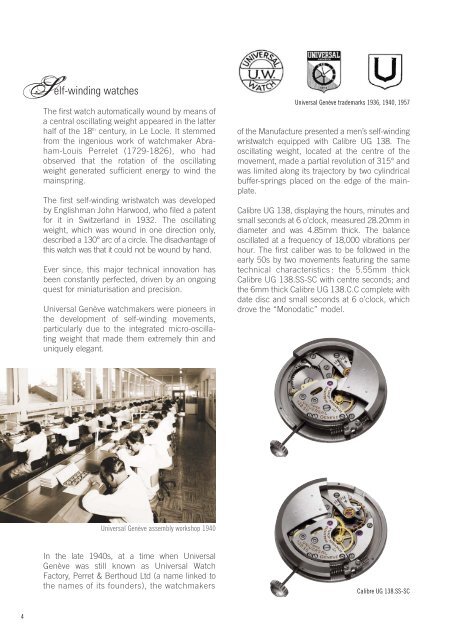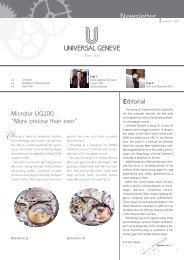Microtor Technology by Universal Genève - Universal Geneve
Microtor Technology by Universal Genève - Universal Geneve
Microtor Technology by Universal Genève - Universal Geneve
Create successful ePaper yourself
Turn your PDF publications into a flip-book with our unique Google optimized e-Paper software.
S<br />
4<br />
elf-winding watches<br />
The first watch automatically wound <strong>by</strong> means of<br />
a central oscillating weight appeared in the latter<br />
half of the 18 th century, in Le Locle. It stemmed<br />
from the ingenious work of watchmaker Abraham-Louis<br />
Perrelet (1729-1826), who had<br />
observed that the rotation of the oscillating<br />
weight generated sufficient energy to wind the<br />
mainspring.<br />
The first self-winding wristwatch was developed<br />
<strong>by</strong> Englishman John Harwood, who filed a patent<br />
for it in Switzerland in 1932. The oscillating<br />
weight, which was wound in one direction only,<br />
described a 130° arc of a circle. The disadvantage of<br />
this watch was that it could not be wound <strong>by</strong> hand.<br />
Ever since, this major technical innovation has<br />
been constantly perfected, driven <strong>by</strong> an ongoing<br />
quest for miniaturisation and precision.<br />
<strong>Universal</strong> <strong>Genève</strong> watchmakers were pioneers in<br />
the development of self-winding movements,<br />
particularly due to the integrated micro-oscillating<br />
weight that made them extremely thin and<br />
uniquely elegant.<br />
<strong>Universal</strong> <strong>Genève</strong> assembly workshop 1940<br />
In the late 1940s, at a time when <strong>Universal</strong><br />
<strong>Genève</strong> was still known as <strong>Universal</strong> Watch<br />
Factory, Perret & Berthoud Ltd (a name linked to<br />
the names of its founders), the watchmakers<br />
<strong>Universal</strong> <strong>Genève</strong> trademarks 1936, 1940, 1957<br />
of the Manufacture presented a men’s self-winding<br />
wristwatch equipped with Calibre UG 138. The<br />
oscillating weight, located at the centre of the<br />
movement, made a partial revolution of 315° and<br />
was limited along its trajectory <strong>by</strong> two cylindrical<br />
buffer-springs placed on the edge of the mainplate.<br />
Calibre UG 138, displaying the hours, minutes and<br />
small seconds at 6 o’clock, measured 28.20mm in<br />
diameter and was 4.85mm thick. The balance<br />
oscillated at a frequency of 18,000 vibrations per<br />
hour. The first caliber was to be followed in the<br />
early 50s <strong>by</strong> two movements featuring the same<br />
technical characteristics : the 5.55mm thick<br />
Calibre UG 138.SS-SC with centre seconds; and<br />
the 6mm thick Calibre UG 138.C.C complete with<br />
date disc and small seconds at 6 o’clock, which<br />
drove the “Monodatic” model.<br />
Calibre UG 138.SS-SC




